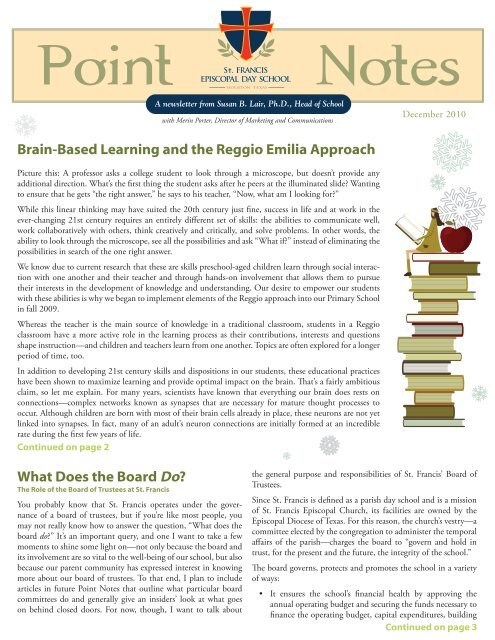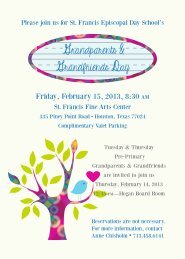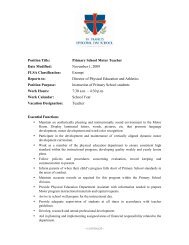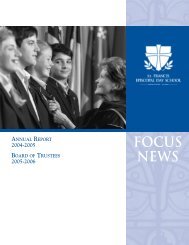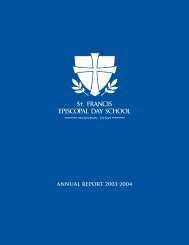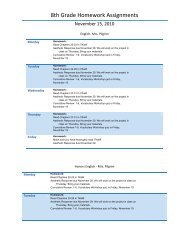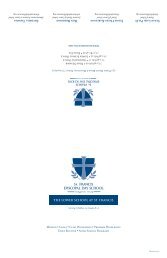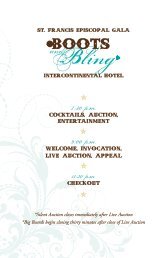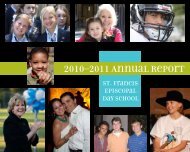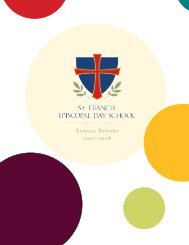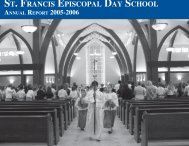Brain-Based Learning and the Reggio Emilia Approach
Brain-Based Learning and the Reggio Emilia Approach
Brain-Based Learning and the Reggio Emilia Approach
Create successful ePaper yourself
Turn your PDF publications into a flip-book with our unique Google optimized e-Paper software.
with Merin Porter, Director of Marketing <strong>and</strong> Communications<br />
December 2010<br />
<strong>Brain</strong>-<strong>Based</strong> <strong>Learning</strong> <strong>and</strong> <strong>the</strong> <strong>Reggio</strong> <strong>Emilia</strong> <strong>Approach</strong><br />
Picture this: A professor asks a college student to look through a microscope, but doesn’t provide any<br />
additional direction. What’s <strong>the</strong> first thing <strong>the</strong> student asks after he peers at <strong>the</strong> illuminated slide? Wanting<br />
to ensure that he gets “<strong>the</strong> right answer,” he says to his teacher, “Now, what am I looking for?”<br />
While this linear thinking may have suited <strong>the</strong> 20th century just fine, success in life <strong>and</strong> at work in <strong>the</strong><br />
ever-changing 21st century requires an entirely different set of skills: <strong>the</strong> abilities to communicate well,<br />
work collaboratively with o<strong>the</strong>rs, think creatively <strong>and</strong> critically, <strong>and</strong> solve problems. In o<strong>the</strong>r words, <strong>the</strong><br />
ability to look through <strong>the</strong> microscope, see all <strong>the</strong> possibilities <strong>and</strong> ask “What if?” instead of eliminating <strong>the</strong><br />
possibilities in search of <strong>the</strong> one right answer.<br />
We know due to current research that <strong>the</strong>se are skills preschool-aged children learn through social interaction<br />
with one ano<strong>the</strong>r <strong>and</strong> <strong>the</strong>ir teacher <strong>and</strong> through h<strong>and</strong>s-on involvement that allows <strong>the</strong>m to pursue<br />
<strong>the</strong>ir interests in <strong>the</strong> development of knowledge <strong>and</strong> underst<strong>and</strong>ing. Our desire to empower our students<br />
with <strong>the</strong>se abilities is why we began to implement elements of <strong>the</strong> <strong>Reggio</strong> approach into our Primary School<br />
in fall 2009.<br />
Whereas <strong>the</strong> teacher is <strong>the</strong> main source of knowledge in a traditional classroom, students in a <strong>Reggio</strong><br />
classroom have a more active role in <strong>the</strong> learning process as <strong>the</strong>ir contributions, interests <strong>and</strong> questions<br />
shape instruction—<strong>and</strong> children <strong>and</strong> teachers learn from one ano<strong>the</strong>r. Topics are often explored for a longer<br />
period of time, too.<br />
In addition to developing 21st century skills <strong>and</strong> dispositions in our students, <strong>the</strong>se educational practices<br />
have been shown to maximize learning <strong>and</strong> provide optimal impact on <strong>the</strong> brain. That’s a fairly ambitious<br />
claim, so let me explain. For many years, scientists have known that everything our brain does rests on<br />
connections—complex networks known as synapses that are necessary for mature thought processes to<br />
occur. Although children are born with most of <strong>the</strong>ir brain cells already in place, <strong>the</strong>se neurons are not yet<br />
linked into synapses. In fact, many of an adult’s neuron connections are initially formed at an incredible<br />
rate during <strong>the</strong> first few years of life.<br />
Continued on page 2<br />
What Does <strong>the</strong> Board Do?<br />
The Role of <strong>the</strong> Board of Trustees at St. Francis<br />
You probably know that St. Francis operates under <strong>the</strong> governance<br />
of a board of trustees, but if you’re like most people, you<br />
may not really know how to answer <strong>the</strong> question, “What does <strong>the</strong><br />
board do?” It’s an important query, <strong>and</strong> one I want to take a few<br />
moments to shine some light on—not only because <strong>the</strong> board <strong>and</strong><br />
its involvement are so vital to <strong>the</strong> well-being of our school, but also<br />
because our parent community has expressed interest in knowing<br />
more about our board of trustees. To that end, I plan to include<br />
articles in future Point Notes that outline what particular board<br />
committees do <strong>and</strong> generally give an insiders’ look at what goes<br />
on behind closed doors. For now, though, I want to talk about<br />
<strong>the</strong> general purpose <strong>and</strong> responsibilities of St. Francis’ Board of<br />
Trustees.<br />
Since St. Francis is defined as a parish day school <strong>and</strong> is a mission<br />
of St. Francis Episcopal Church, its facilities are owned by <strong>the</strong><br />
Episcopal Diocese of Texas. For this reason, <strong>the</strong> church’s vestry—a<br />
committee elected by <strong>the</strong> congregation to administer <strong>the</strong> temporal<br />
affairs of <strong>the</strong> parish—charges <strong>the</strong> board to “govern <strong>and</strong> hold in<br />
trust, for <strong>the</strong> present <strong>and</strong> <strong>the</strong> future, <strong>the</strong> integrity of <strong>the</strong> school.”<br />
The board governs, protects <strong>and</strong> promotes <strong>the</strong> school in a variety<br />
of ways:<br />
• It ensures <strong>the</strong> school’s financial health by approving <strong>the</strong><br />
annual operating budget <strong>and</strong> securing <strong>the</strong> funds necessary to<br />
finance <strong>the</strong> operating budget, capital expenditures, building<br />
Continued on page 3
<strong>Brain</strong>-<strong>Based</strong> <strong>Learning</strong>, continued<br />
In his book “The Art of Changing <strong>the</strong> <strong>Brain</strong>,” Dr. James Zull<br />
reminds us that “learning is physical,” <strong>and</strong> that genuine learning<br />
must use all four areas of <strong>the</strong> cerebral cortex: <strong>the</strong> sensory cortex, <strong>the</strong><br />
temporal integrative cortex, <strong>the</strong> frontal integrative cortex <strong>and</strong> <strong>the</strong><br />
motor cortex. Respectively, <strong>the</strong>se areas of <strong>the</strong> brain are engaged by<br />
activities that provide experience, reflection, abstraction <strong>and</strong> active<br />
testing—<strong>and</strong> good teaching causes students to use all four of <strong>the</strong>se<br />
cortices. We began implementing <strong>the</strong> <strong>Reggio</strong> approach in Primary<br />
School because it engages each of <strong>the</strong>se cerebral areas.<br />
• Experience: During learning, <strong>the</strong> sensory cortex is engaged<br />
through active, h<strong>and</strong>s-on experiences that stimulate <strong>the</strong><br />
senses. Students in <strong>the</strong> Primary School are constantly<br />
encouraged to touch, taste, feel <strong>and</strong> smell items related to <strong>the</strong>ir<br />
current learning topic, ra<strong>the</strong>r than just seeing <strong>the</strong> teacher use<br />
<strong>the</strong>m or hearing <strong>the</strong>m discussed.<br />
• Reflection: To stimulate <strong>the</strong> temporal integrative cortex,<br />
children need to be able to connect a topic with prior experiences<br />
<strong>and</strong> <strong>the</strong>ir world. Our teachers achieve this reflection<br />
by documenting children’s expressed interests <strong>and</strong> using <strong>the</strong>m<br />
as foundations for lessons <strong>and</strong> discussions. In fact, it’s been<br />
proven that when children learn about something <strong>the</strong>y are<br />
already somewhat familiar with, <strong>the</strong>y are much more likely to<br />
remember <strong>the</strong> lesson a few months down <strong>the</strong> road.<br />
• Abstraction: To stimulate <strong>the</strong> frontal integrative cortex,<br />
children must think deeply about a topic, analyze, hypo<strong>the</strong>size,<br />
create, predict <strong>and</strong> syn<strong>the</strong>size information. In a <strong>Reggio</strong><br />
classroom, you will often hear teachers asking students<br />
what <strong>the</strong>y want to know about a particular topic <strong>and</strong> asking<br />
<strong>the</strong>m how <strong>the</strong>y are going to uncover that information, ra<strong>the</strong>r<br />
than always solving <strong>the</strong> children’s problems for <strong>the</strong>m. In this<br />
way, <strong>the</strong> students take an extremely active role in <strong>the</strong> learning<br />
process.<br />
• Active Testing: Finally, to stimulate <strong>the</strong>ir motor cortex,<br />
students need to “pull out” what <strong>the</strong>y have learned about a<br />
topic <strong>and</strong> recreate it in a way <strong>the</strong>y underst<strong>and</strong>. In our Primary<br />
School, <strong>the</strong>y do this through play, movement <strong>and</strong> dance, music,<br />
drama, <strong>and</strong> h<strong>and</strong>s-on artistic endeavors such as painting,<br />
drawings, clay <strong>and</strong> sculpture.<br />
Of course, <strong>Reggio</strong> is only part of our program. The Primary School<br />
has also chosen to use data-driven assessment tools to guide instruction<br />
<strong>and</strong> measure growth, along with documentation <strong>and</strong> portfolio<br />
assessment that are compatible with <strong>the</strong> <strong>Reggio</strong> approach. In<br />
addition, our program continues to offer research-based academic<br />
curriculum that includes direct instruction as well as project-based,<br />
student-driven exploration. We feel that, taken toge<strong>the</strong>r, <strong>the</strong>se<br />
practices are preparing our students for <strong>the</strong> future by giving <strong>the</strong>m<br />
<strong>the</strong> confidence to ask <strong>the</strong> questions, find <strong>the</strong> answers <strong>and</strong> take <strong>the</strong><br />
acceptable risks that will lead to success in <strong>the</strong> 21st century.<br />
In <strong>the</strong> future, <strong>the</strong>re will seldom be only one right answer <strong>and</strong> rarely<br />
be only one path to a solution. By implementing elements of <strong>the</strong><br />
<strong>Reggio</strong> approach toge<strong>the</strong>r with “reading, writing <strong>and</strong> arithmetic,”<br />
our Primary School is teaching students how to brainstorm, how<br />
to come up with new <strong>and</strong> interesting ideas, <strong>and</strong> how to confidently<br />
look past obvious truths into <strong>the</strong> wide world of possibilities.<br />
Christmas at an Episcopal School<br />
Christmas is a beautiful, reverent <strong>and</strong> joyful time at St. Francis. This year, Fa<strong>the</strong>r<br />
Bob Wismer will be leading our celebration of <strong>the</strong> season. He will talk to <strong>the</strong><br />
children about <strong>the</strong> season of Advent, a time of quiet preparation for <strong>the</strong> coming<br />
of Christ; Christmas, <strong>the</strong> celebration of his birth; <strong>and</strong> Epiphany (<strong>the</strong> 12 days of<br />
Christmas) where <strong>the</strong> world began to underst<strong>and</strong> <strong>the</strong> miracle of <strong>the</strong> baby Jesus.<br />
The emphasis will be on <strong>the</strong> religious aspects of Christmas—not Santa, snowmen<br />
<strong>and</strong> reindeer. We will especially focus on <strong>the</strong> preparatory nature of Advent by<br />
having <strong>the</strong> children decorate <strong>the</strong> school—humbly at first <strong>and</strong> <strong>the</strong>n building as we<br />
progress toward <strong>the</strong> glory of Christmas.<br />
On <strong>the</strong> opposite page is a calendar of Christmas events. As always, students in each<br />
grade level will be singing at daytime grade-level concerts. We hold <strong>the</strong>se concerts<br />
during <strong>the</strong> school day ra<strong>the</strong>r than in <strong>the</strong> evening to create a more intimate<br />
atmosphere <strong>and</strong> to allow more children <strong>the</strong> opportunity to share <strong>the</strong>ir gifts of song<br />
at Christmas.<br />
In this season of thanks <strong>and</strong> celebration, <strong>the</strong> St. Francis faculty, staff <strong>and</strong> I would<br />
like to express what blessings you <strong>and</strong> your children are to us. Happy holidays!
The Buzz on <strong>the</strong> Board<br />
Did you know?<br />
• In general, <strong>the</strong> St. Francis Board of Trustees<br />
comprises no fewer than 10 <strong>and</strong> up<br />
to 30 voting members, <strong>and</strong> <strong>the</strong> 2010–11<br />
board has 23 members. Each trustee<br />
has one vote, <strong>and</strong> as a permanent voting<br />
member of <strong>the</strong> board, <strong>the</strong> rector appoints<br />
<strong>the</strong> chair <strong>and</strong> a vestry member. The head<br />
of school serves as <strong>the</strong> board’s president,<br />
<strong>and</strong> o<strong>the</strong>r officers include a vice chair, a<br />
secretary <strong>and</strong> a treasurer, who are chosen<br />
annually by <strong>the</strong> board.<br />
• Board members are elected for a threeyear<br />
term <strong>and</strong> may be asked to serve for<br />
up to three consecutive terms. Each officer<br />
is elected for a one-year term, may be<br />
re-elected, <strong>and</strong> holds <strong>the</strong> office until his or<br />
her successor is appointed.<br />
• The board of trustees comprises <strong>the</strong><br />
rector, <strong>the</strong> head of school, a vestry representative,<br />
19 elected trustees <strong>and</strong> one trustee<br />
emeritus.<br />
Board of Trustees, continued<br />
construction costs <strong>and</strong> scholarship funds. It sets tuition, manages<br />
<strong>the</strong> Endowment Fund, <strong>and</strong> oversees all of <strong>the</strong> school’s fund-raising<br />
activities. Its members also participate in board-approved fundraising<br />
activities, including <strong>the</strong> donation of individual cash or cashequivalent<br />
contributions to Annual Fund, capital campaigns <strong>and</strong><br />
o<strong>the</strong>r fund-raising programs.<br />
• It establishes <strong>the</strong> school’s educational mission <strong>and</strong> general policies,<br />
<strong>and</strong> hires <strong>the</strong> head of school, to whom it grants authority for operating<br />
<strong>the</strong> school in accordance with board policies.<br />
• It creates organizational structure for <strong>the</strong> operation of <strong>the</strong> school,<br />
ensuring a clear delineation of authority <strong>and</strong> proper reporting procedures<br />
to <strong>and</strong> from <strong>the</strong> church <strong>and</strong> <strong>the</strong> school.<br />
• It creates <strong>and</strong> refines <strong>the</strong> school’s long-term strategic plan, which it<br />
<strong>the</strong>n uses as a guide for future decisions.<br />
• It reviews <strong>and</strong> monitors yearly matters using st<strong>and</strong>ing committees.<br />
These committees include <strong>the</strong> Executive Committee, <strong>the</strong> Development<br />
Committee, <strong>the</strong> Finance Committee, <strong>the</strong> Investment Committee<br />
<strong>and</strong> <strong>the</strong> Committee on Trustees (COT). The board chair<br />
may also appoint ad hoc committees to address certain issues, <strong>and</strong><br />
non-trustees may serve on all board committees except <strong>the</strong> COT,<br />
which is composed solely of trustees. (I’ll talk more about what each<br />
of <strong>the</strong>se committees do in future newsletters.)<br />
Essentially, <strong>the</strong> board provides objective, third-party oversight, keeping<br />
a careful watch on St. Francis’ organizational, procedural, strategic <strong>and</strong><br />
financial health <strong>and</strong> making decisions that are designed to keep <strong>the</strong> school<br />
strong, healthy <strong>and</strong> continually advancing.<br />
Come Celebrate <strong>the</strong> Holidays with St. Francis!<br />
Please join us as we celebrate <strong>the</strong> advent season at <strong>the</strong>se 2010 Fine Arts performances <strong>and</strong> celebrations:<br />
Tuesday, December 7<br />
Joyful Sounds Christmas Concert, Fine Arts Center, 7 p.m.<br />
Wednesday, December 8<br />
Chamber Choir Performs, The Treemont, 10:20 a.m.<br />
Thursday, December 9<br />
Joyful Sounds Performs, Schlumberger Solutions Center Lobby, 3:30 p.m.<br />
Chamber <strong>and</strong> Varsity Choirs Concert, Fine Arts Center, 7 p.m.<br />
Friday, December 10<br />
Kindergarten Christmas Program, Fine Arts Center, 1:30 p.m.<br />
Friday, December 10–Friday, December 17<br />
Eighth Grade Catch a Rising Star Art Show, People Place <strong>and</strong> Main Street<br />
Monday, December 13<br />
Fourth Grade Christmas Concert, Fine Arts Center, 1:30 p.m.<br />
Tuesday, December 14<br />
Third Grade Christmas Concert, Fine Arts Center, 1:30 p.m.<br />
Wednesday, December 15<br />
Second Grade Christmas Concert, Fine Arts Center, 1:30 p.m.<br />
Thursday, December 16<br />
First Grade Christmas Concert, Fine Arts Center, 1:30 p.m.<br />
Lessons & Carols, Chamber Choir Performs, Church, 6 p.m.<br />
Friday, December 17<br />
Bridge Nativity Play for Parents, Crum Library, 9:30 a.m.
From St<strong>and</strong>ing Mud to St<strong>and</strong>ing Ovation<br />
St. Francis Dedicates Its Athletics Field<br />
Donors, trustees, faculty <strong>and</strong> friends ga<strong>the</strong>red in <strong>the</strong> st<strong>and</strong>s on November<br />
30, 2010, to officially dedicate <strong>and</strong> bless our new field.<br />
“We are now in a position to play both a field hockey game <strong>and</strong> a football<br />
game on <strong>the</strong> same day, simultaneously, for <strong>the</strong> first time!” said Director of<br />
Athletics <strong>and</strong> P.E. Don Hicks to a clapping crowd.<br />
O<strong>the</strong>r benefits of <strong>the</strong> improvements include <strong>the</strong> following:<br />
• Playing surfaces for all outdoor sports are greatly improved.<br />
• Morning <strong>and</strong> mid-day rain showers now drain quickly so that practices<br />
<strong>and</strong> games can go on without a hitch.<br />
• The track <strong>and</strong> field team has <strong>the</strong> luxury of an improved high jump<br />
area along with a straightaway on <strong>the</strong> east side that has been graded to<br />
accommodate a three-lane 100-meter track.<br />
• Parents <strong>and</strong> o<strong>the</strong>r supporters enjoy a nice walk to <strong>the</strong> bleachers, free<br />
of mud <strong>and</strong> water.<br />
Many thanks to everyone who worked <strong>and</strong> contributed funds to make<br />
phase one of our field improvement project a reality!<br />
The Rev. Stuart A. Bates, rector, assists<br />
board chair Bill Montgomery with <strong>the</strong><br />
offi cial ribbon cutting.<br />
Lacy Williams, Michelle Williams, Laurie<br />
Bilger <strong>and</strong> Larry Wilkins sip hot chocolate<br />
before <strong>the</strong> dedication.<br />
St. Francis Spotlight<br />
Greg Urbani, Seventh-Grade History Teacher<br />
Greg Urbani isn’t <strong>the</strong> business-card<br />
type. A dyed-in-<strong>the</strong>-wool educator,<br />
he says he really doesn’t underst<strong>and</strong><br />
why anyone would choose a different<br />
career. “I have been in school in<br />
some capacity for <strong>the</strong> last 43 years<br />
straight, so it is a part of me,” he<br />
explains. “The thirst for knowledge<br />
<strong>and</strong> <strong>the</strong> richness it brings to your<br />
life cannot be measured—I cannot<br />
imagine doing anything else!”<br />
A seventh-grade world history teacher at St. Francis since 2006,<br />
Mr. Urbani brings to his classroom a teaching style pieced toge<strong>the</strong>r<br />
from <strong>the</strong> influence of every educator who has ever inspired him.<br />
He credits his high school social studies teachers with making <strong>the</strong><br />
biggest impact on his future career choice, which in 21 years has<br />
included every subject that falls within <strong>the</strong> social studies realm.<br />
From teaching history, government <strong>and</strong> economics at middle <strong>and</strong><br />
high schools in <strong>the</strong> Galveston <strong>and</strong> Goose Creek Consolidated<br />
school districts to covering social studies with sixth- through<br />
eighth-graders at St. Mark’s Episcopal School in Houston, he’s<br />
done it all—with a passion.<br />
“There is nothing more satisfying to me than catching hold of an<br />
entire class <strong>and</strong> realizing that in that moment <strong>the</strong>y are all focused<br />
on your every word,” he remarks enthusiastically. Mr. Urbani says<br />
he wants his students to come to school every day wanting to learn<br />
about history. To this end, he tailors his curriculum to include<br />
all learning styles in order to reach every student. A member <strong>and</strong><br />
conference attendee of <strong>the</strong> Texas <strong>and</strong> National Councils for <strong>the</strong><br />
Social Studies, he has also participated in <strong>the</strong> Council for Economic<br />
Studies seminar <strong>and</strong> is trained in Advanced Placement government<br />
<strong>and</strong> economics, as well as differentiated learning.<br />
After receiving a Sarah W. Woolrich Fund award in 2008, Mr.<br />
Urbani traveled to Italy, a trip that he says “opened my eyes <strong>and</strong><br />
changed <strong>the</strong> way I teach <strong>the</strong> ancient cultures in our curriculum.”<br />
With a wife who is a history teacher as well, he says <strong>the</strong> experience<br />
awakened a desire to travel abroad <strong>and</strong> walk <strong>the</strong> roads that those in<br />
his books have walked. At home, Mr. Urbani is an ardent cook in<br />
<strong>the</strong> kitchen <strong>and</strong> cyclist on <strong>the</strong> streets, <strong>and</strong> is an active member of<br />
<strong>the</strong> NorthWest Cycling Club. He says he is always trying to learn<br />
about new subjects <strong>and</strong> hopes he will stir his students to do <strong>the</strong><br />
same. He concludes: “There are very few quintessential moments<br />
in life, <strong>and</strong> I hope that somehow I can be a part of <strong>the</strong>ir lives in <strong>the</strong><br />
present or future decisions that <strong>the</strong>y make.”<br />
Point Notes is published throughout <strong>the</strong> school year by St. Francis Episcopal Day School (335 Piney Point Rd., Houston, TX 77024,<br />
www.sfedshouston.org). Its purpose is to provide Head of School Dr. Susan B. Lair with a direct communication link to <strong>the</strong> school‘s<br />
parent community. Produced by <strong>the</strong> Department of Marketing <strong>and</strong> Communications.


